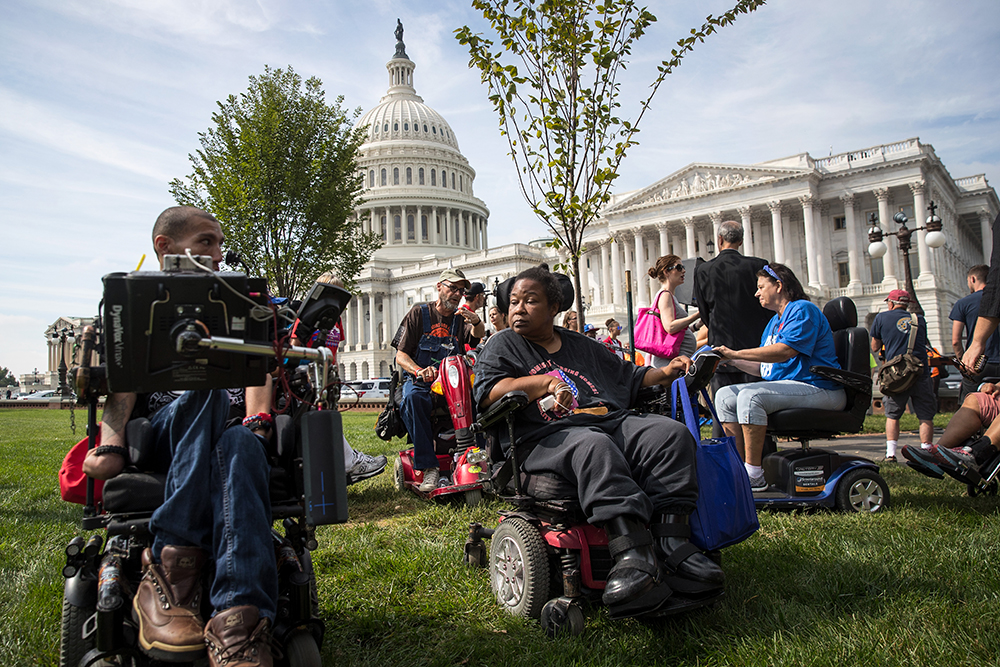Right now, Congress is in a deadlock over Brett Kavanaugh, Trump’s nominee to the Supreme Court. Senators are reviewing more than 1 million pages of his legal writing—which have laid out his stance on women’s reproductive rights (opposed), the Consumer Financial Protection Bureau (opposed), and the Affordable Care Act (opposed)—and members are battling over access to additional documentation that could reveal past experience with torture and wiretapping. While many of Kavanaugh’s opinions have been controversial—in particular his dissent from a decision that allowed an immigrant woman to have an abortion—one of his most problematic rulings has gone unreported. As a Judge in D.C. Circuit Court, Kavanaugh argued that people with disabilities could be forced to undergo elective surgeries, including abortion, without their consent.
Get TalkPoverty In Your Inbox
In 2001, three intellectually disabled D.C. residents brought suit against the city in Doe ex rel. Tarlow v. D.C, after they were subjected to at least three involuntary procedures: two abortions and one elective eye surgery. Ultimately, the district court agreed that these women’s due process rights had been violated and that “constitutionally adequate procedures” had not been followed. The District Court ruled for the plaintiffs and held that D.C. must make “documented reasonable efforts to communicate” with patients and if unsuccessful, the government had to take into account the “totality of circumstances” before proceeding to ensure any decision is in the best interest of the patient. This decision codified patients’ right to self-determination, and struck down the practice of elective surgeries without consent from the patients at stake.
On appeal, Judge Kavanaugh vacated the District Court’s injunction, arguing that “accepting the wishes of patients who lack, and have always lacked the mental capacity to make medical decisions does not make logical sense.” That stands in contrast to even the most conservative interpretations of the laws that existed at the time, which required two separate health professionals to determine whether a patient had the capacity to make medical decisions before every procedure. The lifetime pass Kavanaugh seems to be arguing for, which would allow doctors to perform any procedures they wanted on a person who was once ruled unfit, does not exist.
One hundred years ago, Kavanaugh’s ruling would have been at home on the Supreme Court. In the 1920’s, in the famous 8-1 ruling of Buck v. Bell, the Supreme Court found a Virginia statute that allowed for the sexual sterilization of a third generation, “feebleminded” women was constitutional because “three generations of imbeciles are enough.”
For context, when the Supreme Court made that ruling, John Scopes had recently been put on trial for teaching evolution in public schools. Penicillin hadn’t been invented. It was still illegal in most states to marry someone of a different race. There was no such thing as a chocolate chip cookie, Scotch tape, or the Golden Gate Bridge. We didn’t know Pluto existed.
We’ve made progress since then. Twenty-eight years ago, the Americans with Disabilities Act granted people with disabilities access to society. The Individuals with Disabilities Education Act expanded the right to an education 43 years ago, and the Olmstead v. L.C. decision gave disabled people the right to live in their communities 19 years ago. All that will be meaningless the moment Kavanaugh is given a seat on the Supreme Court that allows him to rule that disabled Americans are not capable of deciding what’s best for them. It’s not hard to imagine that happening. He could rule that it’s okay for teachers to use seclusion and restraint because they know what’s best for the treatment of disabled children in school. He could say that community living isn’t the best option for someone successfully living in a home of their own because that’s what the nursing home lobby says.
As both Democrats and Republicans in the Senate gear up for what is likely to be a long hearing process, the 57 million Americans with disabilities are bracing themselves for the negative consequences of Judge Kavanaugh’s appointment. If that happens, the disability community’s history of activism in all forms—from their work to preserve the ACA, to fighting to end the use of electric shock therapy on children, to pushing for a fair day’s pay for a fair day’s work—shows that when it’s most needed, the moral arc of the universe can be bent into a ramp to achieve justice.











